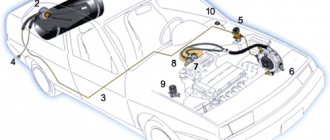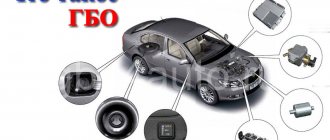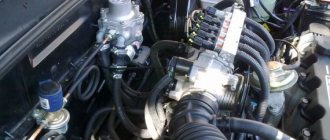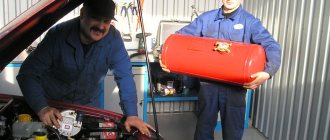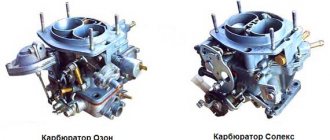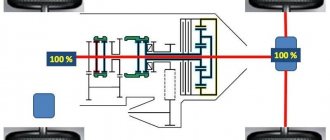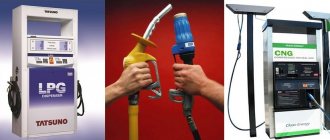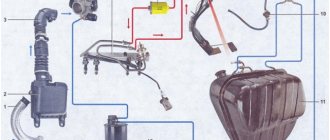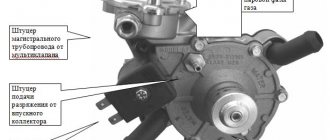About HBO → Third generation of HBO
The third generation gas cylinder unit differs from the second generation systems by the presence of its own control unit, mechanical nozzles, and the absence of a gas mixer. Simultaneous injection of the gas-air mixture into the manifold was carried out next to the intake valves. This made it possible to practically reduce the possibility of popping to zero.
- Principle of operation
- Difference
- Environmental standards, displacement from the market
- Discrepancy between HBO generations according to classification
- Injection cars with third generation gas equipment
- Carburetor cars with third-generation LPG installation
Principle of operation
In third-generation LPG installations, the distribution dispenser, in parallel with the electronic unit, controls the supply of fuel to the manifold via injectors. The block receives signals from the TPS - sensor that fixes the throttle position, MAP - the sensor that fixes absolute pressure, the oxygen sensor, RPM - the sensor that fixes engine speed. The designers in this system installed a single-stage version instead of a two-stage gearbox. The supply of the gas mixture was adjusted due to the resistance of the spring when a vacuum was created in the manifold.
All reducer-evaporators of gas treatment plants, starting from the third generation, operate with excess, constant pressure. The dispenser supplies the gas mixture separately to each cylinder. The opening of mechanical injectors occurs due to the formation of excess pressure in the pipeline. The electronic unit of the third-generation LPG unit generates its own fuel maps. The design features of the block dispenser do not allow the concentration of the gas-air mixture to be adjusted quickly enough. Despite this, HBO 3 systems are actively used by car manufacturers. With proper equipment installation and periodic maintenance, the injectors worked for quite a long period of time.
Carburetor engine
It is possible to install a 3rd generation LPG kit for an engine equipped with a carburetor, but there are some difficulties. For example, you need to install a lambda probe from an injection machine in order to control the quality of the prepared mixture using the exhaust gases of an internal combustion engine. Another difficulty is to track the complete loss of gasoline fuel from the carburetor float chamber, and then switch to electronic control of the quantitative supply of gas fuel.
In general, the composition of the HBO 3 kit takes the following form:
- gas cylinder;
- filling valve;
- multivalve;
- throttle position sensor;
- filling and supply line;
- coarse filter (often built into the evaporator reducer);
- reducer-evaporator (electronic);
- switch button with operation indication “GAS” or “Petrol” with wiring;
- dispenser equipped with an electronic stepper motor.
- mixer (for mixing propane-butane mixture with air);
- gasoline electric valve (which shuts off the supply of gasoline to the carburetor when the engine is running on gas).
Environmental standards, displacement from the market
On third-generation LPG installations, the electronic-mechanical valve remains. This did not provide the ability to adjust the fuel at the required speed. Therefore, third-generation LPG devices fully complied with Euro-2 standards. When Euro-3 standards were introduced, new OBD II, EOBD second-generation on-board diagnostic systems were developed. Third generation HBO devices have become less in demand. As a result, they were finally forced out of the LPG market by fourth-generation units.
Advantages and disadvantages of equipment
The advantages include:
- relatively simple installation and adjustment of equipment;
- reduction in gas fuel consumption;
- no popping noises in the intake manifold;
- reduction of exhaust toxicity;
- minimizing car engine power loss;
- reliability of the system (with proper maintenance and gas quality).
Flaws:
- slow response of the fuel distributor to changes in engine operating modes (low speed of adjustment of the fuel mixture);
- high cost and lack of main components (the gearbox costs about 10 thousand rubles, the price of a stepper motor is 6 thousand rubles);
- use on cars not higher than Euro-2 standards;
- low maintainability.
The emergence of Euro-3 standards has led to a reduction in the use of third-generation gas equipment. The system is transitional between the 2nd and more advanced 4th generation.
The difference between 3rd and 4th generation HBO is significant. In the fourth generation, the gas mixture is in a constant-pressure reducer and is injected using electronic injectors. The absence of a distributor, mechanical injectors, as well as fine tuning of the control unit makes the operation of such equipment more efficient.
Discrepancy between HBO generations according to classification
Due to the fact that third-generation gas equipment lasted on the Russian market for a relatively short time, without gaining further distribution, a number of installers also forgot about it. As a result, they simply raised the previous systems by one level, that is, the first generation of HBO became the second, the second, respectively, the third. In order not to be confused in the qualifications of HBO, it is better to use the names “lambda control system”, “gas carburetor”. Already from the fourth generation there are no differences in qualifications.
Differences with predecessors and the reason for leaving the market shelves
The improved HBO 3 system has the ability to refuse the use of computing power. This also applies to the fuel map, and it is mainly stored in standard controllers as gasoline fuel. Installing this map allows you to work on the system in parallel mode, so another formulation suggests itself: creating an individual fuel map.
Also, the adjustment of this system does not allow the supplied mixture to be adjusted correctly and within the required range, and this happens due to the low level of reaction speed. And this may also be due to a stepper dispenser specially introduced into the system, which acts as a distributor.
When environmental requirements of Euro 3 class appeared, as well as the possibility of adjusting on-board diagnostics, demand for HBO 3 among car enthusiasts dropped significantly compared to the previous generation. This also includes the emergence of an improved gas-gas system installed in a car engine and a pricing policy that has increased significantly.
The development of the 4th generation and high cost had a negative impact on the demand for the system, and the 4th generation practically displaced sales of the 3rd generation from the market.
In addition, it is worth noting that the use of type 3 gas equipment applies to carburetor types of vehicles.
Injection cars with third generation gas equipment
An injector is a mechanical device that allows the fuel mixture to be sprayed into the engine.
The gas cylinder is most often installed on the rear side of the vehicle, more precisely in the trunk instead of the spare wheel. The filling device is mounted in the area of the rear wing of the car, the bumper. A gas pipeline is laid along the section of the gasoline pipeline. The gas valve is located under the hood of the vehicle on the left. The mixer is located to the left of the motor, which makes it possible to subsequently connect it to the cooling system without any obstacles. The control unit is usually installed in a car showroom. The gas distributor is installed near the manifold.
To secure the injectors, several holes are first made in the manifold. Then the emulator is connected to the injector nozzles. The lambda probe and throttle sensor are connected to the control unit. Further, after the measures taken to install the gas equipment, the system is configured, adjusted, and checked, which is necessary to identify possible gas leaks and eliminate them instantly.
Setting up the fuel system
Correct adjustment of 3rd generation gas equipment is carried out by adjusting the gas pressure in the evaporator reducer; it can be done with your own hands, if you have certain skills and equipment. ECU calibration is not required (the controller does not use standard fuel maps).
After checking the functionality of the standard gasoline system and eliminating gas leaks, to adjust the pressure in the gearbox stages, you will need a special differential pressure gauge.
Pressure gauge connection diagram
1st stage:
By connecting the pressure gauge to the hole on the gearbox (remove the plug) and the hose from the intake manifold, start the internal combustion engine. After warming up the engine at idle speed, adjust the pressure using the screw on the rear cover of the evaporator (1.4 atm.). Disconnect the device, insert the plug, check for leaks.
2nd stage:
Connect the pressure gauge to the manifold (as in the first option), and its second hose to the distributor (removing the cover at the bottom). Then adjust the screw on the front cover of the gearbox (0.95 atm). Disconnect the device and check the functionality of the system.
Carburetor cars with third-generation LPG installation
For carburetor cars, third-generation LPG devices are also used due to the presence of their own control unit. In such a situation, there is no need to use an injector emulator that supplies the fuel mixture and powers the vehicle’s on-board computer. This happens when a car engine runs on a gas mixture.
Due to the fact that there is no possibility of using an injector emulator, it becomes necessary to use a gasoline valve that blocks the gasoline supply. There is also one small nuance that does not allow a carburetor engine to function normally - the mandatory use of a lambda probe and a throttle position fixation sensor. This deficiency must be eliminated, which is not so easy to do.
On carburetor engines, it is practiced to replace the electronic unit and fuel distributor with a standard vacuum reducer-regulator. In such a situation, a gas-cylinder installation is immediately equated to the first generation.
Description and equipment
HBO 3 is designed for converting to gas fuel both cars equipped with a carburetor and injection gasoline engines.
The new components for HBO 3 are:
- electronic dispenser with a stepper motor (as opposed to a conventional dispenser with an adjusting bolt/bolts),
Electronic dispenser
- and the electronic control unit itself for this dispenser.
The sixth generation and its differences from previous ones
So far, there are difficulties with purchasing 6th generation LPG, even if you are a consumer from Europe. The system was developed in one of the European countries. Direct fuel injection system is the main distinguishing feature of such systems. The system is simply plugged into the gas fuel supply; there are practically no distinctions.
When you press one button, the gas supply is activated, the other is responsible for turning on gasoline. The gas cylinder equipment system is greatly simplified thanks to this combination of parts. Now gas receives all modern characteristics and advantages, including:
- Easy maintenance.
- Minimum amount of required equipment.
- Improved ecology.
- Consumption.
- Power is up to par.
Even in Europe, production of the sixth generation is just beginning. Deliveries to Russia are planned in the near future.
Setting the “response” to pressing the gas pedal and the amount of gas supplied
Once the idle speed has been set, it is necessary to ensure that the engine responds quickly and picks up speed when you press the gas. To do this, you need to gradually unscrew the sensitivity adjusting screw until the idle speed begins to change. As soon as a change in idle speed has been noticed, the specified screw must be screwed back 2/3 of 1 full turn or one and a quarter turns (depending on the particular internal combustion engine, etc.).
When finished, you need to press the gas pedal, first smoothly, then you can press it sharply. The main thing is that if the setting is done correctly, there should be no failures, the engine should quickly exit the idle mode, respond adequately to pedaling, rev up well and respond quickly to any pressing of the gas pedal.
- After the settings have been completed and the response to the gas pedal is satisfactory, you need to move on to the settings of the dispenser itself. To do this, you should raise the speed, on average, to 3 or 3.5 thousand rpm without suction. For these purposes, it is better to invite an assistant who will press the gas.
So, when the position of the screw leading to a change in speed has been found, the screw should be unscrewed from this position by half or 3/4 of a quarter of a turn. Please note that if a dispenser is installed that has two sections, then all the manipulations described above are carried out with the first chamber.
The second chamber is set to 1/3 of the first. If the reducer also has the ability to adjust the pressure of the first stage, then additional actions will be required.
- First of all, the engine must be turned off, after which the gas line is closed. Then a pressure gauge is connected to the cavity of the first stage. The connection itself is made through a control hole, which is closed with a screw.
- As for the pressure gauge, the device should have a scale of 1.5 kgf per square centimeter. After connecting, open the gas supply and start the engine. In idle mode, the pressure in the first stage is adjusted using the pressure gauge.
- The indicator should remain 0.38-0.42. Having set the pressure, adjustments to the idle speed and sensitivity of the gearbox should be carried out again.
